If you’re in the US today, there’s probably little chance you didn’t know it was Memorial Day – from the specials on TV, to local events, to remembrance stories, and even community gatherings, it’s hard to miss the message of today’s holiday. I had planned to take the day off from work to remember and reflect on the service of those in my family (my grandfather, now passed), and in my community. Just before noon, I decided to go online and see what those in my networks were sharing from their own celebrations or reflections, and immediately found the #GoSilent campaign from Iraq and Afghanistan Veterans of America (IAVA). It pulled me in, and then everywhere I looked online I saw it was pulling in others!
A simple commitment
One key to the spreadable and shareable success of the IAVA campaign is that the ask is clear but very simple: to go silent for one minute at 12:01 pm today in honor those who have given their life in service, and their families. The timing coincides with the President’s remarks in Arlington, but one minute of silence can be pledged at any time, really.
The simple call to action also lends itself to participation by many, including government officials. Here’s an example of a Senator showing his support for veterans through participation in the #gosilent pledge:
Tracking silence
IAVA’s #gosilent campaign is a terrific example of social campaigning because it uses tools and tactics that make it easy for the organization to track, measure, and evaluate success – in real time and after the campaign is over. For starters, using a hashtag that is clear to understand (#gsfvt “go silent for veterans today” would be really confusing!), obviously tied to the campaign, and reflective of the call to action means it is likely people will use it and engage. Plus, there are many tools to track the usage of hashtags and even archive them or annotate them, making both the tracking and the reporting much more streamlined.
IAVA also set up a microsite for the campaign, in this case it is a specially-designed sub-section of their main website that is branded and focused on the #GoSilent pledge. It shows a pledge counter, providing a sense of collective participation as soon as you visit the site, and asks you to take the pledge:
You are then prompted to fill out some basic information. I think it is incredibly smart that they include the drop down menu for Veteran Status. This will help them segment and personalize messages in the future based on service involvement, or civilian status.
The thank you page provides direct links to encourage sharing immediately, making it easy for someone to spread the link and hashtag to their networks. You will also note that the pledge counter has increased just in the 30 seconds or so that it took to fill out the form on the previous screen. For many people, when they give money or make a pledge online, they want to see that thermometer increase, or the dial move, or the counter jump ahead. IAVA has done a great job ensuring a live count is active on the site for visitors to see their number add to the total.
Sharing across platforms – Twitter
IAVA have made it clear from the thank you page that they are concentrating their efforts on Facebook and Twitter where they have a large community and many people and many different organizations will also be promoting Memorial Day activities. Here’s an example of the Twitter stream following #gosilent where you can see a message from IAVA, someone sharing a video of Taps filmed in Arlington Cemetery, someone dedicating their moment of silence to classmates, and tweets in direct reply to each other giving thanks for service. The #gosilent hashtag is not just a stream of people posting a templated message or retweeting a call to action from IAVA, but is truly a coming together of people remembering and honoring veterans – exactly as the campaign would want it to be.
Sharing across platforms – Facebook
On Facebook, IAVA updated their cover photo and profile photo to align with the campaign for today and combined make a great example of using the Timeline profile features:
There are a few key features I want to point: First, since the Facebook Page guidelines specifically say you cannot include URLs, they’ve used a great work around by making their profile photo the hashtag. Most people, at least those that would be participating on social tools, would recognize the number sign and phrase as a hashtag and use it in their posts, or search for it to see posts from others. Another terrific decision they made was to include the carrot “>” with a call to action “Sign the Pledge with IAVA”. We’ve been conditioned that when we see a carrot and a call to action online that we can click there to be directed to the next step. However, since it is a Facebook photo, when you click on it, the photo opens in a preview viewer and you can see further information and the link to the microsite in the photo description to the right. Both of these actions make it clear and easy for people to learn more and take action while still playing by the rules of Facebook.
Sharing across platforms – Instagram and Foursquare
IAVA didn’t confine their own use of social tools to Facebook and Twitter, as their supporters would be using other tools, too. The key to true cross-channel engagement like the #gosilent campaign is to link your accounts or use common profile names so that supporters can easily find you. In this case, they were also able to use the campaign hashtag to find participants and have them tag their content anywhere so it was tied into the campaign.
Here we can see a photo taken to accompany a FourSquare check in:
You can also see examples of Instagram photos being shared on Instagram with the #gosilent hashtag:
Instagram photos being shared on Twitter with the #gosilent hashtag:
And even Instram photos being shared on the IAVA Facebook page (note the number of shares and likes in just an hour!):
I’m really excited by the way that IAVA used social media today to celebrate Memorial Day by connecting their supporters, growing their supporter base, serving their mission, and helping so many people be part of something simultaneously local wherever they were and in the nation’s capital. I think it’s a terrific example of the way we can coordinator content and actions across channels to help spread a message or a campaign.
Sharing across platforms – Email and mobile
Whenever I’m checking out or even participating in a campaign across social channels, I always watch for an email to see how the organization has planned to use the email address I gave them when I donated, pledged, or otherwise signed up, to engage with me again right away. IAVA’s #gosilent campaign did send an email to thank me for pledging, and even though it is a text-only email, they make sure to hyperlink text to direct people to share on Facebook and Twitter. Additionally, they use this email to provide ways for people to share back with IAVA how they are going silent and remembering those that have served – the email even offers that people can simply email their stories or photos right to IAVA directly, providing a way for those that don’t want to share or are not using social media to still participate.
Additionally, the email offers a mobile short code that people can use to sign up for a text message reminder before the 12:01 moment of silence. Again, I think this is an excellent example of getting sign-ups in your database, helping people follow through on the call to action, and moving on your mission. I am curious to know how they follow up with the mobile subscribers or invite them into future campaigns via their phones.
What did you do to celebrate Memorial Day today? Did you #gosilent?

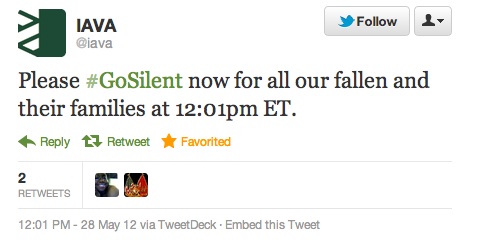
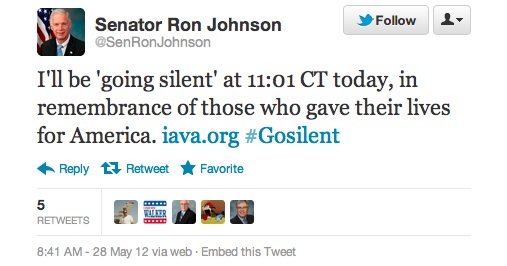
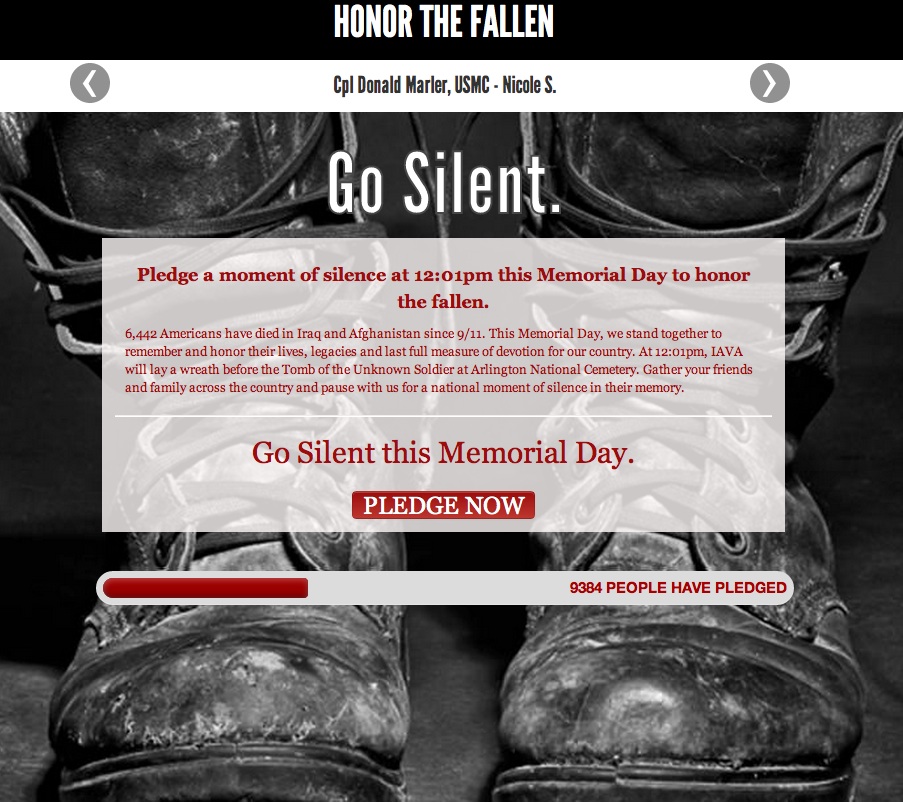
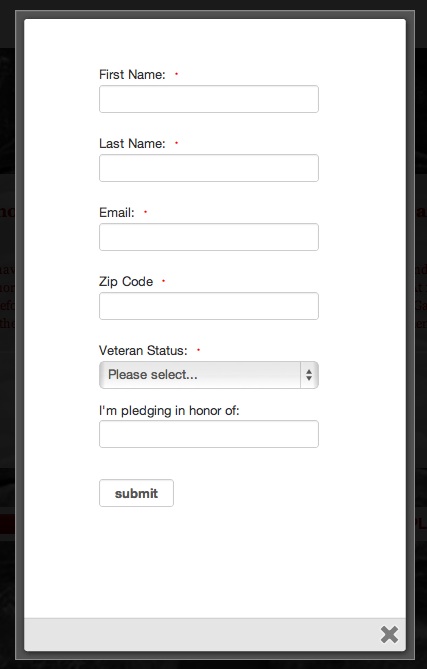

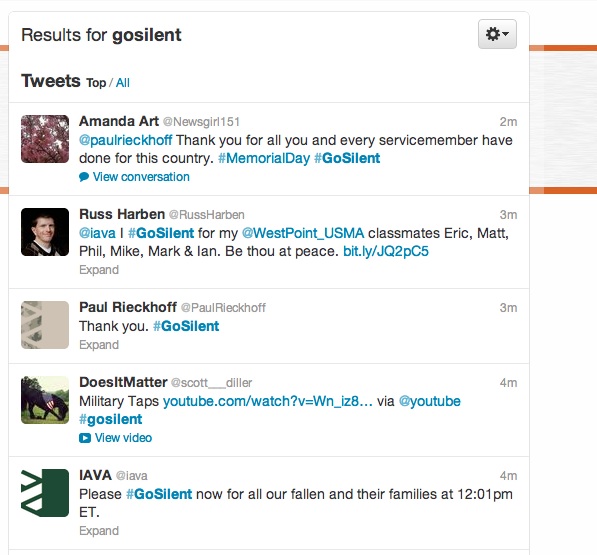

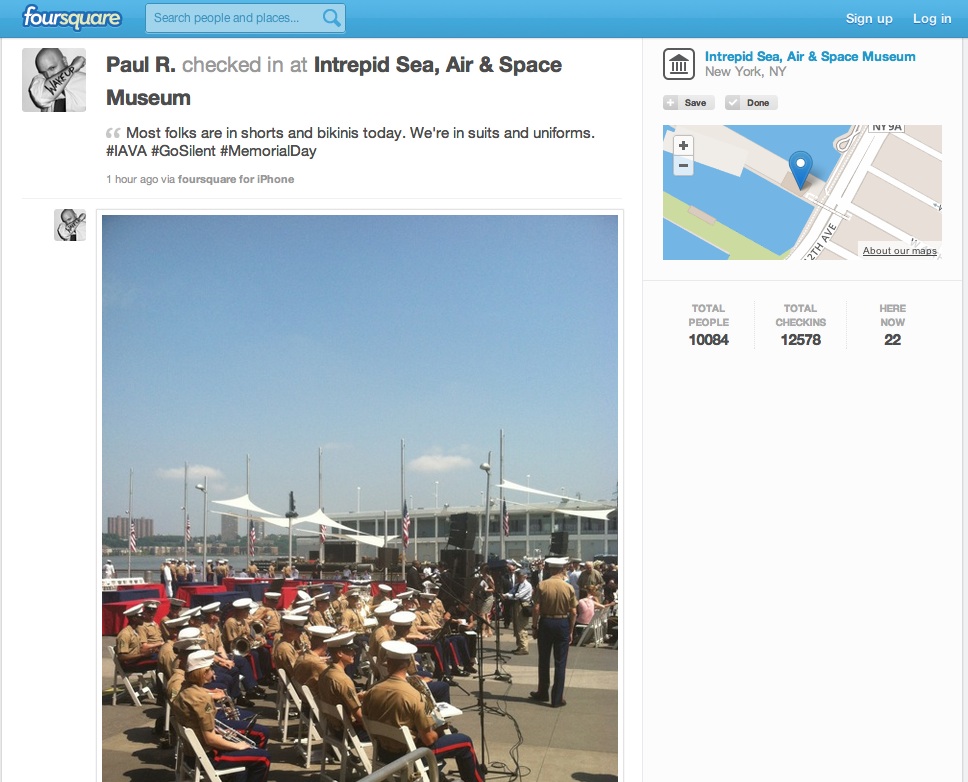



such a great break-down of an important awareness-building campaign (and a great org) … thanks for taking the time to write this up
cheers, Michael! happy to document and share 🙂
Thanks for highlighting our work, Amy. Your insights are fantastic. We hope #GoSilent will be an annual event, and a national movement. Please stay in touch! @PaulRieckhoff, Founder of @IAVA.
Cheers, Paul! Thanks so much for checking in here. I think we will continue to be in touch via NTEN but I’ll certainly keep my eye out for other opportunities to cover your work on my blog. Any chance you’d be interested in writing up a guest post from your perspective on #GoSilent? How you planned it, what kinds of metrics were important, how you evaluated “success”?